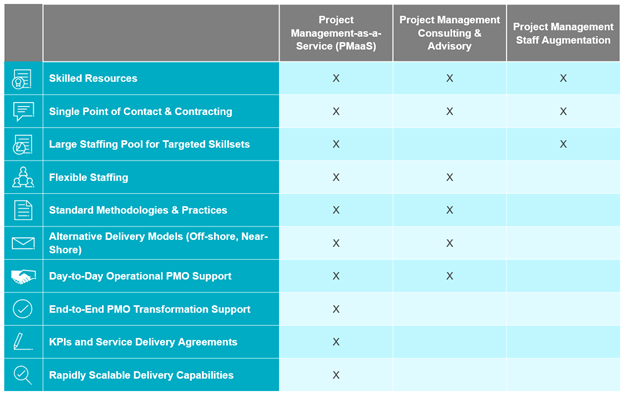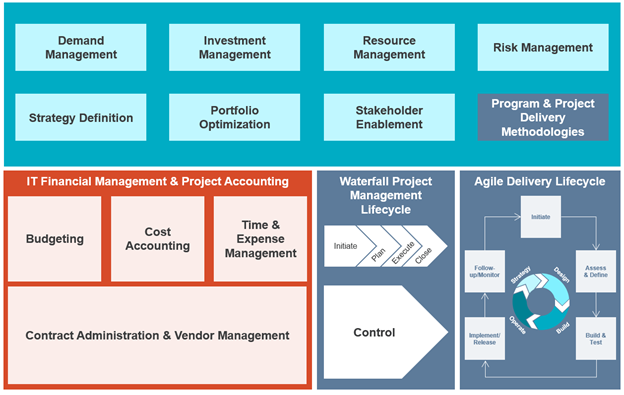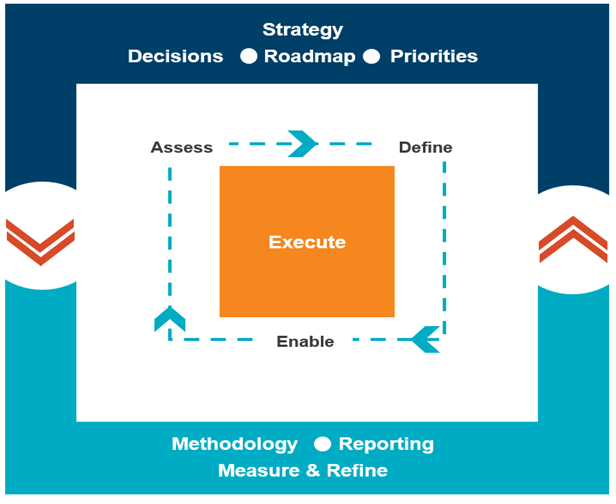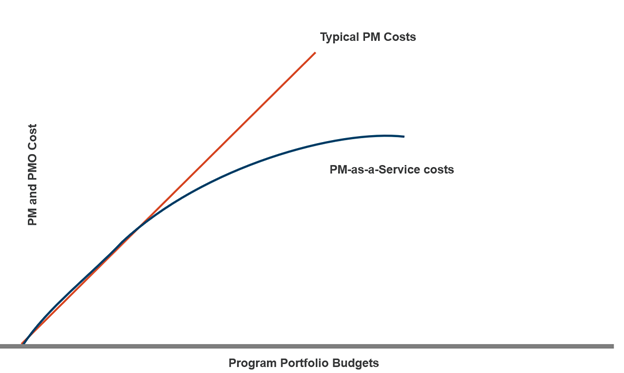The program management office (PMO) function today is expected to deliver highly complex transformation activities that cannot be solved using traditional methods. PMOs must be capable of partnering at all levels, both internally and externally, and must exhibit speed, expertise and scalability. As a result, many market leaders are turning to a robust, scalable program management as a service (PMaaS) solution to innovate while rapidly transforming their PMO.
What is Project Management as a Service?
PMaaS is a shift from the conventional views on, and execution of, project and program management activities, in the same way that software-as-a-service (SaaS) and infrastructure-as-a-service (IaaS) transformed hosting and IT support strategies. As with SaaS and IaaS, organizations can scale up and scale down the services provided by a PMaaS provider and select the right-fit blend of services.
In our prior blog post, “Seven Key Factors to a Successful PMO Transformation,” we discussed how demands on the PMO have shifted the requirements of the function, making administrative, process-heavy methods obsolete. When properly executed, a PMaaS model builds on traditional PMO approaches, as shown in Table 1 below.
Table 1: Project Management Service Delivery

With a PMaaS solution, organizations can establish a scalable model that enables them to transform their PMO fundamentally and rapidly. By right-fitting the PMO to business priorities and employing next-generation project and program management professionals, collaboration tools, and governance frameworks and risk-mitigation techniques, organizations can innovate and execute at scale. In this way, PMaaS provides for a nimble PMO that more closely reflects many organizations’ agile transformation objectives.
How PMaaS Can Drive Transformation
The most frequent question we hear from organizations looking to undertake a PMO transformation concerns “where to start.” This can be a daunting task, as the PMO must look to transform itself while continuing to deliver against ongoing project and program schedules, often with a limited budget. It is common for the PMO to be so busy working in the business that it lacks the bandwidth to work on the business. While a typical PMO staff augmentation can provide qualified and skilled project managers, a PMaaS approach provides the expertise to execute and transform all critical areas of the PMO function, as illustrated in Figure 1 below.
Figure 1: An Example of a PMO Execution Model

How to Right-Fit your PMaaS Solution
An agile catalyst framework model (as shown in Figure 2) can help drive PMO transformation efforts while ensuring delivery of in-flight programs and projects remains uninterrupted.
Figure 2: An Agile Catalyst Framework Model

Furthermore, for organizations looking for surge project management capabilities to respond to capital projects, or for companies that do not wish to maintain the overhead of a full PM function, PMaaS provides on-demand, cost-effective scalability. Utilizing right-shore capabilities can further cost-effectiveness objectives while minimizing the organization’s need to establish its own offshore or nearshore capabilities. As shown in Figure 3 below, these techniques provide economies of scale as the portfolio grows.
Figure 3: PMaaS Budget Value

Overall, regardless of the PMaaS model implemented, there are four easily attained benefits:
- Rapid transformation of PMO capabilities to increase experience and become more innovative
- Accelerated value with program initiatives/value streams aligned to top business priorities
- Increased focus on competitive advantage activities as leadership time is freed up
- Improved costs while attaining the three points above.
PMaaS in Action
A recent example of PMaaS in action involved a rapidly growing financial services industry leader. The company was experiencing multiple competing priorities from core legacy platform modernization, regulatory demands, resilience, and the need to improve its agility to keep up with the growing digital product needs of customers. The company was able to identify the right PMaaS solution and, within 45 days:
- Rapidly scaled experienced program and project management professionals to lead critical value stream programs through to completion
- Tactically integrated a project manager with technical expertise into IT operations teams with minimal oversight
- Standardized processes broadly across the organization using turnkey collaboration tools and materials
- Increased transparency and consistency through automated reporting tools
- Enabled cost savings, first by reducing the need to expand hiring and staffing overhead, and then by bringing overbudget projects and programs into alignment by aggressively scoping to value-based deliverable objectives and eliminating any elements not tied to top business priorities.
Today’s transformation issues require speed, expertise and scalability that cannot be satisfied by continuing to use traditional methods. Leaders in organizations cannot solve new problems with old solutions. To innovate, they must rethink their approach. As many market leaders reconsider their PMO operating model, they are leveraging PMaaS to meet the future head-on.
In the next blog of this series, we will share why it is important to align the project portfolio to value streams effectively and the benefits that can be achieved.






